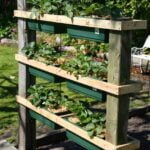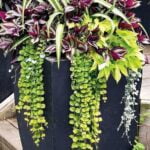Landscape curbing is a crucial element in creating visually appealing and well-maintained outdoor spaces. This article will explore various landscape curbing ideas, from materials and design options to the best plants to pair with it. Whether you are considering DIY options or hiring a professional, this comprehensive guide will help you make the right choices for your landscaping needs.
Landscape curbing serves many purposes, from defining different areas of the yard to providing a clean edge between the lawn and flowerbeds. It also helps in preventing soil erosion and retaining mulch, ultimately enhancing the overall look of your outdoor space. This article will delve into the importance of landscape curbing and how it can significantly impact the aesthetic appeal of your home.
Understanding what landscape curbing is and its significance is essential before diving into specific ideas and projects. The following sections will cover everything from materials, design options, lighting incorporation, maintenance tips, and case studies to give you a holistic understanding of landscape curbing ideas. Whether you’re a seasoned gardener or new to landscaping, this comprehensive guide has something for everyone looking to enhance their outdoor space with beautiful landscape curbing.
Materials for Landscape Curbing
When it comes to landscape curbing, choosing the right materials is crucial in achieving the desired look and functionality for your outdoor space. There are several options available, each with its own set of advantages and limitations. Concrete is a popular choice for landscape curbing due to its durability and versatility. It can be molded into various shapes and designs, making it suitable for both traditional and modern landscaping styles.
Plastic landscape curbing offers a more affordable alternative to concrete, making it an attractive option for budget-conscious homeowners. While not as durable as concrete, plastic edging is easy to install and comes in a variety of colors and styles, allowing for greater design flexibility.
Metal landscape curbing, such as aluminum or steel, provides a sleek and modern look to outdoor spaces. These materials are known for their strength and resistance to harsh weather conditions, making them ideal for high-traffic areas.
For those looking to add a touch of natural beauty to their landscape, natural stone options such as granite or limestone can create a timeless and elegant border for gardens and pathways. While natural stone may be more expensive than other materials, its unique textures and earthy tones can enhance the overall aesthetic of any outdoor setting.
When considering landscape curbing ideas, it’s important to weigh the cost, maintenance requirements, and visual appeal of each material option before making a decision that best suits your needs.
Design and Style Options for Landscape Curbing
When it comes to landscape curbing, there are numerous design and style options to consider. Whether you prefer a traditional look or want something more decorative and unique, the choice is yours. Here are some design and style options for landscape curbing:
- Traditional: If you prefer a classic and timeless look for your landscape curbing, traditional options such as straight lines and simple shapes may be the best choice for you. This type of design complements a wide range of outdoor spaces and can give your landscaping a polished and neat appearance.
- Decorative: For those looking to add a touch of flair to their landscaping, decorative landscape curbing might be the way to go. This option includes intricate patterns, ornate details, and unique textures that can elevate the overall look of your outdoor area.
- Stamped: Stamped landscape curbing offers the opportunity to mimic the appearance of natural stone, brick, or other materials without the high cost. With a variety of patterns and colors available, stamped curbing can add visual interest and character to your landscape.
- Colored: Adding color to your landscape curbing can create a visually striking effect in your outdoor space. Whether you opt for earthy tones to blend in with the surroundings or bold hues to make a statement, colored curbing is an excellent way to enhance the overall aesthetic of your landscaping.
By exploring these design and style options for landscape curbing, you can find the perfect fit for your outdoor space that aligns with your personal preferences and complements your existing landscaping elements. Whether you choose traditional, decorative, stamped, or colored curbing, there are plenty of options available to bring your landscape vision to life.
DIY vs Hiring a Professional
When it comes to landscape curbing, deciding whether to take on the project yourself or hire a professional is an important decision. Both options have their own set of pros and cons that should be considered before making a choice.
One of the main benefits of taking the DIY approach to landscape curbing is cost savings. By doing the work yourself, you can avoid labor and installation fees, which can add up when hiring a professional. Additionally, DIY projects allow for complete creative control, giving you the freedom to design and execute your landscape curbing ideas exactly as envisioned.
On the other hand, hiring a professional for landscape curbing comes with its own advantages. Professionals bring expertise and experience to the table, ensuring that the job is done correctly and efficiently.
They also have access to specialized tools and equipment that may not be readily available to DIYers. Another benefit of hiring a professional is time savings – while it may take you several days or even weeks to complete a landscape curbing project on your own, professionals can often complete the job in a fraction of the time.
Ultimately, whether you choose DIY or hire a professional for your landscape curbing project will depend on factors such as budget, time constraints, and individual skill level. It’s important to carefully weigh the pros and cons of each option before making a decision.
Best Plants and Flowers to Pair With Landscape Curbing
When it comes to landscaping with curbing, choosing the right plants and flowers to pair with your design is crucial. The right foliage can complement the style of your curbing while requiring minimal maintenance. Here are some low-maintenance options to consider for pairing with your landscape curbing ideas.
Native Grasses and Succulents
Native grasses and succulents are excellent choices for pairing with landscape curbing. These plants require little water and upkeep, making them perfect for busy homeowners or those looking for a hassle-free garden. Ornamental grasses such as fountain grass or blue fescue add texture and movement, while succulents like sedum or hens-and-chicks bring pops of color without demanding much attention.
Perennial Flowers
For a burst of seasonal color that comes back year after year, consider planting perennial flowers alongside your landscape curbing. Low-maintenance options like coneflowers, black-eyed Susans, or daylilies are not only visually appealing but also resilient in various weather conditions, making them ideal for pairing with any style of curbing.
Drought-Tolerant Shrubs
Drought-tolerant shrubs are an excellent choice for blending with landscape curbing ideas, especially in regions prone to dry spells. Plants like lavender, juniper, or yucca not only require little watering once established but also offer structure and formality to your garden design. Additionally, their hardy nature means they can withstand the occasional neglect while still adding visual interest to your landscaping.
Creative Ideas for Incorporating Lighting Into Landscape Curbing
When it comes to landscape curbing, incorporating lighting can truly elevate the look and feel of your outdoor space. There are various creative ideas for integrating lighting into landscape curbing, adding both aesthetic appeal and functionality to your yard or garden. Lighting can enhance the ambiance of your outdoor area, highlight the features of your landscape curbing, and provide safety and security during nighttime.
One popular option for incorporating lighting into landscape curbing is to use low-voltage LED lights. These can be installed along the border of the curbing, either embedded or mounted on top, to provide a soft glow that accents the shape and texture of the curbing.
Additionally, solar-powered lights are an environmentally friendly and cost-effective choice for illuminating landscape curbing. These lights can be easily placed along the edge of the curbing without the need for wiring or electricity.
Another creative idea is to use rope lighting within the groove of the landscape curbing. This type of lighting provides a subtle yet impactful effect, creating a continuous line of light that outlines and highlights the curves and edges of the curbing. Furthermore, you can consider installing spotlights aimed at specific architectural or landscaping features near the curbing, such as ornamental trees, statues, or water elements, to add depth and dimension to your outdoor space.
Incorporating lighting into landscape curbing not only adds visual interest to your property but also serves practical purposes by illuminating pathways, driveways, and garden beds. Whether you choose LED lights embedded in the border or rope lights within the groove, thoughtful integration of lighting will contribute to a stunning nighttime display while enhancing safety and security in your outdoor environment.
Maintenance Tips for Keeping Landscape Curbing in Top Shape
Landscape curbing can be a stunning addition to any outdoor space, but proper maintenance is key in keeping it looking its best. Whether you have concrete, plastic, metal, or natural stone landscape curbing, regular care and upkeep will ensure its longevity and visual appeal. Here are some maintenance tips for keeping landscape curbing in top shape.
First and foremost, it’s essential to regularly inspect your landscape curbing for any signs of damage or wear. Cracks, chips, or shifts in the material should be addressed promptly to prevent further deterioration. For concrete curbing, filling in cracks with a specialized concrete filler and applying a sealant can help protect it from moisture and other environmental factors.
In addition to addressing any visible damage, routine cleaning is necessary to keep landscape curbing looking fresh. Use a pressure washer or a garden hose with a nozzle attachment to remove dirt, debris, and organic matter that may have accumulated along the edges.
For plastic or metal curbing, a mild soap solution can also be used to scrub away stubborn stains. Regular cleaning not only improves the appearance of the curbing but also prevents it from becoming a breeding ground for pests and pathogens.
Lastly, consider resealing or reapplying protective coatings as needed to safeguard your landscape curbing from weathering and fading. This is particularly important for colored or stamped designs that may be more susceptible to losing their vibrancy over time. By staying on top of maintenance tasks like these, you can ensure that your landscape curbing remains an attractive and functional element of your outdoor space for years to come.
| Maintenance Tips | Description |
|---|---|
| Regular Inspection | Inspect for cracks, chips, or shifts in the material. |
| Routine Cleaning | Use pressure washer or mild soap solution to remove dirt and debris. |
| Resealing/Reapplying Coatings | To protect against weathering and fading. |
Case Studies
Landscape curbing is a great way to enhance the overall look of your yard or garden. By adding a border between your lawn and other landscape features, you can create a cleaner and more polished appearance. There are numerous landscape curbing ideas that you can use to transform your outdoor space, whether you prefer a traditional or decorative style.
One popular material for landscape curbing is concrete, which offers durability and versatility. You can opt for straight lines or curved designs to complement the shape of your garden beds and pathways. Plastic and metal options are also available for those who prefer a more affordable and lightweight alternative. If you’re looking for a natural touch, consider using natural stone for a rustic and organic feel in your landscaping.
When it comes to design and style options, there are various choices to suit different preferences. Traditional landscape curbing provides a simple and clean look, while decorative options offer intricate patterns and textures. Stamped concrete allows you to mimic the appearance of natural materials such as brick or wood, while colored concrete enables you to add a pop of color to your outdoor space.
For those who enjoy DIY projects, installing landscape curbing can be a fulfilling task. However, hiring a professional can ensure a precise and professional finish. Consider the pros and cons of each option before making a decision based on your skill level and available time. By carefully selecting the right plants and flowers to pair with your landscape curbing, you can create an aesthetically pleasing combination that requires minimal maintenance.
Conclusion
In conclusion, the world of landscape curbing offers a wide range of possibilities for homeowners and property owners. From concrete to natural stone options, the materials available for landscape curbing can fit any style and budget.
The design and style options are also diverse, with traditional, decorative, stamped, and colored choices to elevate the look of any outdoor space. Whether you choose to tackle a DIY project or hire a professional installation team, there are pros and cons to consider for each option.
When it comes to pairing plants and flowers with landscape curbing, low maintenance options are always a great choice. This ensures that your outdoor space remains beautiful without requiring too much upkeep. Additionally, incorporating lighting into landscape curbing can add a unique touch to your outdoor area while providing safety and security at night.
As you consider implementing landscape curbing ideas for your own property, it’s important to keep up with maintenance in order to keep everything looking its best for years to come. Regular cleaning and repair will help ensure that your landscape curbing stays in top shape. Before starting your project, be sure to look at case studies and before-and-after photos of successful projects for inspiration and guidance.
Whether you’re looking to enhance the appeal of your home or boost the aesthetic of a commercial property, landscape curbing can make a significant difference. With so many options available in terms of materials, design styles, and lighting integration, there’s no shortage of ways to make your outdoor space stand out.
By taking these final thoughts into consideration as you move forward with implementing landscape curbing ideas, you’ll be well on your way to achieving an impressive result that enhances the overall look and function of your property.
Frequently Asked Questions
Is Concrete Landscape Curbing Worth It?
Concrete landscape curbing can be worth it for homeowners who prioritize durability and longevity in their landscaping. It provides a permanent and customizable border for flower beds, pathways, and other areas of the yard.
While it may require a larger upfront investment than other edging options, its long-term benefits can make it a worthwhile choice for those looking for a low-maintenance and lasting solution.
What Is the Best Low Maintenance Landscape Edging?
The best low maintenance landscape edging often depends on the specific needs of the yard and personal preferences. However, materials like metal or plastic strips are popular choices due to their durability, flexibility, and ease of installation. These options require minimal upkeep and provide a clean and tidy edge to the landscaping without requiring regular maintenance or replacement.
What Do You Put Under Landscape Edging?
Under landscape edging, it’s common to put down a barrier or liner to help prevent weeds from growing into the landscaped areas. Materials like landscaping fabric or plastic sheeting can be used as an underlayment to suppress weed growth while still allowing proper drainage for plants.
This extra layer can help maintain the neat appearance of the landscape while reducing the need for ongoing weeding efforts.

Welcome to my gardening blog! I am passionate about plants and enjoy sharing my knowledge and experiences with others. In this blog, I will write about everything related to gardening, from tips on how to get started to updates on my own garden projects.





